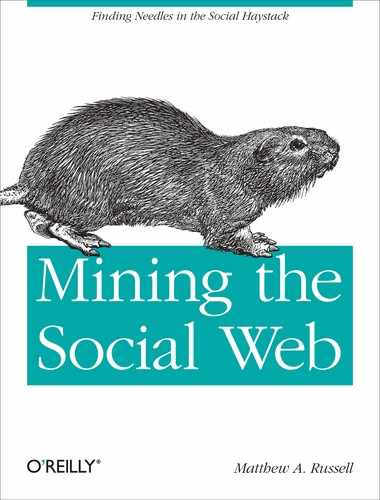There are a ridiculous number of obvious things you can do with tweet data, and if you get the least bit creative, the possibilities become beyond ridiculous. We’ve barely scratched the surface in this chapter. An entire book could quite literally be devoted to systematically working through more of the possibilities, and many small businesses focused around tweet analytics could potentially turn a fairly healthy profit by selling answers to certain classes of ad-hoc queries that customers could make. Here are interesting ideas that you could pursue:
Define a similarity metric and use it to compare or further analyze two Twitter users or groups of users. You’ll essentially be developing a profile and then measuring how well a particular user fits that profile. For example, do certain hashtags, keywords (e.g., LOL, OMG, etc.), or similar metrics appear in #JustinBieber tweets more than in more intellectual tweets like ones associated with #gov20? This question might seem obvious, but what interesting things might you learn along the way while calculating a quantifiable answer?
Which celebrity Twitterers have a very low concentration of tweet entities yet a high tweet volume? Does this make them ramblers—you know, those folks who tweet 100 times a day about nothing in particular? Conversely, which celebrity Twitterers have a high concentration of hashtags in their tweets? What obvious comparisons can you make between the two groups?
If you have a Twitter account and a reasonable number of tweets, consider analyzing yourself and comparing your tweet streams to those of other users. How similar are you to various Twitterers along a particular spectrum?
We didn’t broach the subject of Twitter’s lists API. Can you profile various members of a list and try to discover latent social networks? For example, can you find a metric that allows you to approximate political boundaries between followers of the @timoreilly/healthcare and @timoreilly/gov20 lists?
It might be interesting to analyze the volume of tweets or content of tweets by time of day. This is a pretty simple exercise and could incorporate the SIMILE Timeline—discussed in Visualizing Mail “Events” with SIMILE Timeline—for easy visualization.
Near real-time communication is increasingly becoming the norm and Twitter provides a streaming API, which provides convenient access to much of their “fire hose.” See the online streaming documentation and consider checking out
tweepyas a terrific streaming client.
